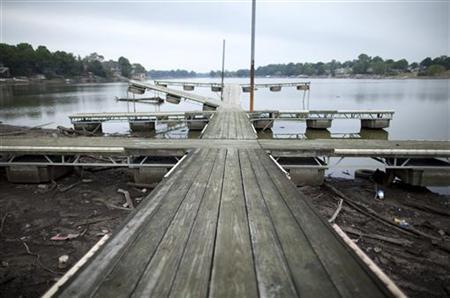July was hottest month ever for continental US: NOAA
Date: 09-Aug-12
Country: USA
Author: Deborah Zabarenko

A boat dock now rests in mud at Morse Reservoir as water levels drop
due to the current drought near Cicero, Indiana July 19, 2012.
Photo: Chris Bergin
July was the hottest month in the continental United States on record, beating the hottest month in the devastating Dust Bowl summer of 1936, the US government reported on Wednesday.
It was also the warmest January-to-July period since modern record-keeping began in 1895, and the warmest 12-month period, eclipsing the last record set just a month ago, the National Oceanic and Atmospheric Administration (NOAA) said.
This is the fourth time in as many months that U.S. temperatures broke the hottest-12-months record.
The average temperature for July across the contiguous 48 states was 77.6 degrees F (25.3 degrees C), or 3.3 degrees F (1.7 degrees C) above the 20th century average. The previous warmest July, in 1936, averaged 77.4 degrees F (25.2 degrees C).
Along with record heat, drought covered nearly 63 percent of the 48 contiguous states, according to NOAA's Drought Monitor, with near-record drought conditions in the Midwest, where 75 percent of the U.S. corn and soybean crops are grown.
Analysts expect the drought, the worst since 1956, will yield the smallest corn crop in six years, meaning record-high prices and tight supplies. It would be the third year of declining corn production despite large plantings.
The government will make its first estimate of the fall harvest on Friday. It already has cut projections for corn yields by 12 percent due to hot, dry weather in the Farm Belt.
Drought and heat fed each other in July, according to Jake Crouch, a scientist at NOAA's National Climatic Data Center.
Dry soils in the summer tend to drive up daytime temperatures, and because dry soils prevailed over so much of the United States, that helped make things hotter over a wide area, Crouch said by telephone.
"The hotter it gets, the drier it gets, the hotter it gets," Crouch said.
What made this year different from the Dust Bowl summer of 1936 was nighttime temperatures, he said. In the Dust Bowl years, the warmth was largely driven by daytime highs. This July, the record heat was also pushed by warm nighttime temperatures -- the overnight lows weren't that low.
President Barack Obama called on Congress on Tuesday to pass a farm bill so disaster aid can flow to livestock producers. Crop insurance will provide a safety net for row-crop growers but ranchers have much less of a federal cushion. Crop insurance indemnities could be double or triple last year's level because of the wide-spread drought, say initial estimates by economists.
The drought triggered a surge in the prices for U.S. corn and soybeans to record highs last month, with values rising about 50 percent and 30 percent, respectively, over the past two months.
Sharp price increases the United States, the world's largest grower and exporter of these two commodity crops, have sparked global concern over potential increases in food prices after a similar surge led to food riots in dozens of countries in 2008.
(Reporting By Deborah Zabarenko, Environment Correspondent; Additional reporting by Charles Abbott in Washington, K.T. Arasu in Chicago; ; Editing by Sandra Maler)
![]()
© Thomson Reuters 2012 All rights reserved